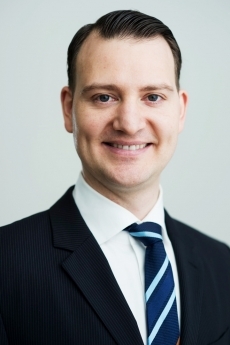Getting to Know: Professor Volker Sorger

Professor Volker Sorger is an associate professor in the Department of Electrical and Computer Engineering and director of the Devices and Intelligent Systems Lab and the Orthogonal Physics Enabled Nanophotonics (OPEN) Lab. His research focuses on intelligent information systems, AI hardware, cryptography and novel devices. Among Professor Sorger's breakthroughs are the first photonic tensor processing unit (TPU), convolutional neural network ASIC accelerators, and emerging IT devices such as light signal modulators and lasers. He was recently elected a 2022 Optica Fellow. In 2020, Professor Sorger co-founded the company, Optelligence, with two of his collaborators.
Please describe, in simple terms, what Optelligence is about, who the founders are, and the research development efforts that you conduct within the company.
Optelligence is a deep-tech venture innovating on AI hardware and software as well as on cryptography. I co-founded Optelligence in 2020 alongside Dr. Dalir and Mr. Movahhed. Each of us adds unique value and rich experience to the company.
How did you become interested in this field of research? And what motivated you to start the company?
I was always interested in converting ideas and innovations into real products that could enter the market. Seeding this interest, while my background is in engineering, I completed the Management of Technology certificate , a tech-related MBA from UC Berkeley focusing on innovation and technology from the Haas Business School. In addition, I went through NSF and GW I-Corps programs learning to think about solutions rather than (only) about technologies. The many opportunities available right now in hardware AI systems triggered the founding of Optelligence. This is a golden era for hardware development! Secondly, we secured several key patents in this space so we are well suited to explore this technology further.
What is the significance of the company’s product in terms of practical applications?
We keep developing a number of technologies. This includes artificial intelligence systems both for network edge-computing and for cloud applications. We provide systems and services in machine learning accelerators that are more efficient and speed up the process of machine learning. Network-edge applications include decision-making and data pre-processing in smart phones, satellites, or autonomous vehicles. Self-driving cars, for example, need many, many sensors to navigate, to steer, to track. On the security side, we are looking into new algorithms for encryption and decryption as well as something called “hashing,” which is essential to make the cyberspace more secure.
What are the challenges or limitations associated with this field of research that the company strives to address?
Challenges include the communication and design of systems spanning multiple disciplines such as optical and photonic engineering, signal processing, digital and mixed-signal processing, algorithms, cryptography, AI and software development. Access and lead-times to chips is another challenge, and packaging photonic chips is yet to be optimized from a foundry-ecosystem point of view, impacting yield and hence cost. So yes, it is a complex ecosystem.
What are the goals of the company? What are you hoping to achieve?
The soul of the company is to innovate and explore new products and services that can offer dramatic improvements for clients and end-users. We are a vertically integrated company, similar to Apple, not laterally integrated, for example, like Dell. We are building an ecosystem of innovators, life-long-learners but also pragmatists such as product designers and a customer pipeline. We believe we can challenge the status-quo of computer and information processing by co-designing solutions with both hardware, algorithms and the software application in mind. If there is a better and more creative way to do it, we are curious to explore that.
Is there anything about your company that you think makes it unique from others in this area?
Ours is a very unique perspective on design-thinking. We try to approach these complex problems and challenges from a holistic view, and in the process we’ve found a few bottlenecks that others have not addressed, at least not openly. Also the communication with the founders, with the mutual expertise with a different ecosystem and networks, provides novel insights for ideation and scale-up.
What successes or milestones has your company reached thus far?
We have attracted several government contracts thus far and attracted a pre-sale contract from a private investor over eight figures, which is rather special in deep-tech. Our company is valued at $140 million right now. We are building a headquarters for the first 50 employees and are planning a grand opening before the end of this year.
Are you, in your company, collaborating with anyone else? Who funds your R&D efforts?
Since technology is part of a vertical value-chain, partnering with larger organizations such as the government and major DoD contractors as well as the semiconductor industry is key. As such, indeed, we have several collaborations.
What role do GW students play in the company?
Optelligence offers internship and employment opportunities. As such, students have the opportunity to accelerate their careers and grow within the company. Students gain industry insights, providing a real-world perspective on the technologies they are working on while earning their doctorate or masters, or working as post-doctoral researchers. Overall, this is a wonderful opportunity for students - Google and Facebook have started like this!
What do you gain from their involvement?
We are fortunate to work with such smart and bright minds to develop innovative, unique and inspiring solutions for tough problems.
Anything else you would like to state?
I would like to thank everyone at GW and Optelligence involved in making this a success thus far. It is a great opportunity for all of us! Onwards it is.

